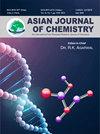Co(II), Ni(II), Cu(II) and Zn(II) Metal Complexes of Hydrazone Schiff Base Ligand: Synthesis, Characterization, Thermal Behaviour, Antioxidant and Antimicrobial Studies
Q4 Chemistry
引用次数: 0
Abstract
The metal(II) complexes of ML type of Co(II), Ni(II), Cu(II) and Zn(II) were synthesized using hydrazone Schiff base, N',N"-((1E,2E)-acenaphthylene-1,2-diylidene)bis(2-hydroxy benzohydrazide), which was synthesized by the condensation of acenaphthaquinone and 2-hydroxy benzohydrazide (1:2 molar ratio) in ethanol and characterized by various spectroscopic and analytical techniques, including UV-visible, FTIR, 1H NMR, 13C NMR, LC-MS, TGA-DSC, powder XRD and atomic absorption measurements. The magnetic susceptibility and electronic spectral data suggested that the Ni(II) and Cu(II) complexes have octahedral geometry, while the Co(II) and Zn(II) complexes have tetrahedral geometry. It has also been found that all the metal(II) complexes are paramagnetic, except Zn(II) complex. The molar conductance values indicated that all the metal(II) complexes are non-electrolytes in DMSO solvent. The stability of metal(II) complexes, the absence of coordinated and lattice water molecules in complexes and the proposed formula were all validated by the thermal analysis. All the compounds have average crystallite sizes on the nanoscale, according to powder XRD results. All of the compounds were tested for their in vitro antimicrobial activities against six bacteria (B. subtilis, S. aureus, Corynebacterium, P. aeruginosa, K. pneumoniae and E. coli) and three fungi (C. albicans, A. flavus and A. niger) at two different concentrations.腙席夫碱配体的 Co(II)、Ni(II)、Cu(II) 和 Zn(II) 金属配合物:合成、表征、热行为、抗氧化和抗菌研究
使用腙席夫碱、N',N"-((1E,2E)-苊烯-1,2-二亚基)双(2-羟基苯并吡嗪)合成了 Co(II)、Ni(II)、Cu(II)和 Zn(II)的 ML 型金属(II)配合物,该腙席夫碱是由苊醌和 2-羟基苯并吡嗪(摩尔比为 1:通过各种光谱和分析技术,包括紫外可见光、傅立叶变换红外光谱、1H NMR、13C NMR、LC-MS、TGA-DSC、粉末 XRD 和原子吸收测量,对其进行了表征。磁感应强度和电子能谱数据表明,镍(II)和铜(II)配合物具有八面体几何形状,而钴(II)和锌(II)配合物具有四面体几何形状。研究还发现,除 Zn(II) 复合物外,所有金属(II)复合物都具有顺磁性。摩尔电导值表明,所有金属(II)配合物在二甲基亚砜溶剂中都是非电解质。金属(II)络合物的稳定性、络合物中配位水分子和晶格水分子的缺失以及所提出的公式都通过热分析得到了验证。根据粉末 X 射线衍射结果,所有化合物的平均结晶尺寸均为纳米级。测试了所有化合物在两种不同浓度下对六种细菌(枯草杆菌、金黄色葡萄球菌、棒状杆菌、绿脓杆菌、肺炎双球菌和大肠杆菌)和三种真菌(白僵菌、黄曲霉和黑曲霉)的体外抗菌活性。
本文章由计算机程序翻译,如有差异,请以英文原文为准。
求助全文
约1分钟内获得全文
求助全文
来源期刊

Asian Journal of Chemistry
化学-化学综合
CiteScore
0.80
自引率
0.00%
发文量
229
审稿时长
4 months
期刊介绍:
Information not localized
 求助内容:
求助内容: 应助结果提醒方式:
应助结果提醒方式:


